Weakening Orchestral Tempo
VerifiedAdded on 2022/09/11
|6
|1752
|12
AI Summary
Contribute Materials
Your contribution can guide someone’s learning journey. Share your
documents today.
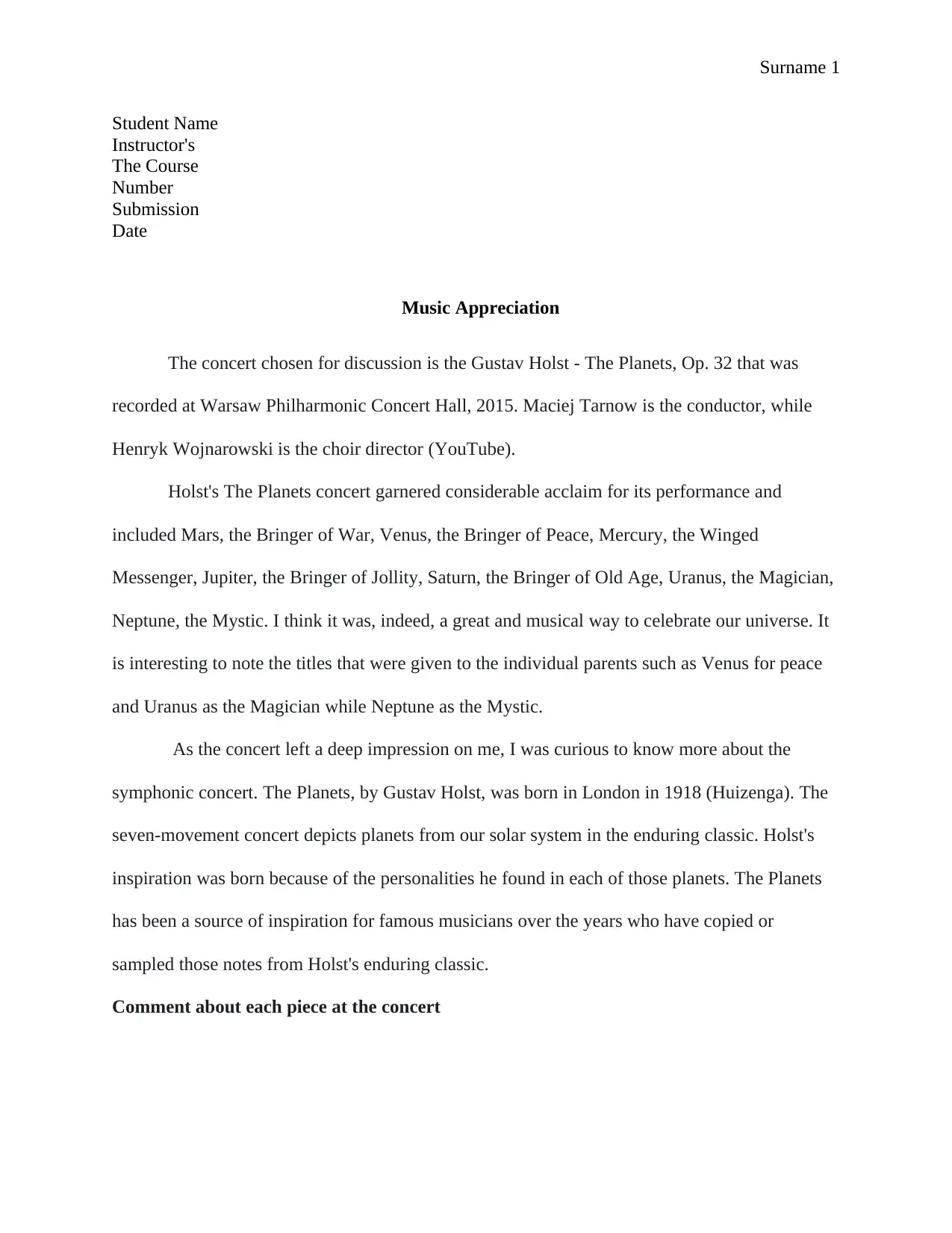
Surname 1
Student Name
Instructor's
The Course
Number
Submission
Date
Music Appreciation
The concert chosen for discussion is the Gustav Holst - The Planets, Op. 32 that was
recorded at Warsaw Philharmonic Concert Hall, 2015. Maciej Tarnow is the conductor, while
Henryk Wojnarowski is the choir director (YouTube).
Holst's The Planets concert garnered considerable acclaim for its performance and
included Mars, the Bringer of War, Venus, the Bringer of Peace, Mercury, the Winged
Messenger, Jupiter, the Bringer of Jollity, Saturn, the Bringer of Old Age, Uranus, the Magician,
Neptune, the Mystic. I think it was, indeed, a great and musical way to celebrate our universe. It
is interesting to note the titles that were given to the individual parents such as Venus for peace
and Uranus as the Magician while Neptune as the Mystic.
As the concert left a deep impression on me, I was curious to know more about the
symphonic concert. The Planets, by Gustav Holst, was born in London in 1918 (Huizenga). The
seven-movement concert depicts planets from our solar system in the enduring classic. Holst's
inspiration was born because of the personalities he found in each of those planets. The Planets
has been a source of inspiration for famous musicians over the years who have copied or
sampled those notes from Holst's enduring classic.
Comment about each piece at the concert
Student Name
Instructor's
The Course
Number
Submission
Date
Music Appreciation
The concert chosen for discussion is the Gustav Holst - The Planets, Op. 32 that was
recorded at Warsaw Philharmonic Concert Hall, 2015. Maciej Tarnow is the conductor, while
Henryk Wojnarowski is the choir director (YouTube).
Holst's The Planets concert garnered considerable acclaim for its performance and
included Mars, the Bringer of War, Venus, the Bringer of Peace, Mercury, the Winged
Messenger, Jupiter, the Bringer of Jollity, Saturn, the Bringer of Old Age, Uranus, the Magician,
Neptune, the Mystic. I think it was, indeed, a great and musical way to celebrate our universe. It
is interesting to note the titles that were given to the individual parents such as Venus for peace
and Uranus as the Magician while Neptune as the Mystic.
As the concert left a deep impression on me, I was curious to know more about the
symphonic concert. The Planets, by Gustav Holst, was born in London in 1918 (Huizenga). The
seven-movement concert depicts planets from our solar system in the enduring classic. Holst's
inspiration was born because of the personalities he found in each of those planets. The Planets
has been a source of inspiration for famous musicians over the years who have copied or
sampled those notes from Holst's enduring classic.
Comment about each piece at the concert
Secure Best Marks with AI Grader
Need help grading? Try our AI Grader for instant feedback on your assignments.
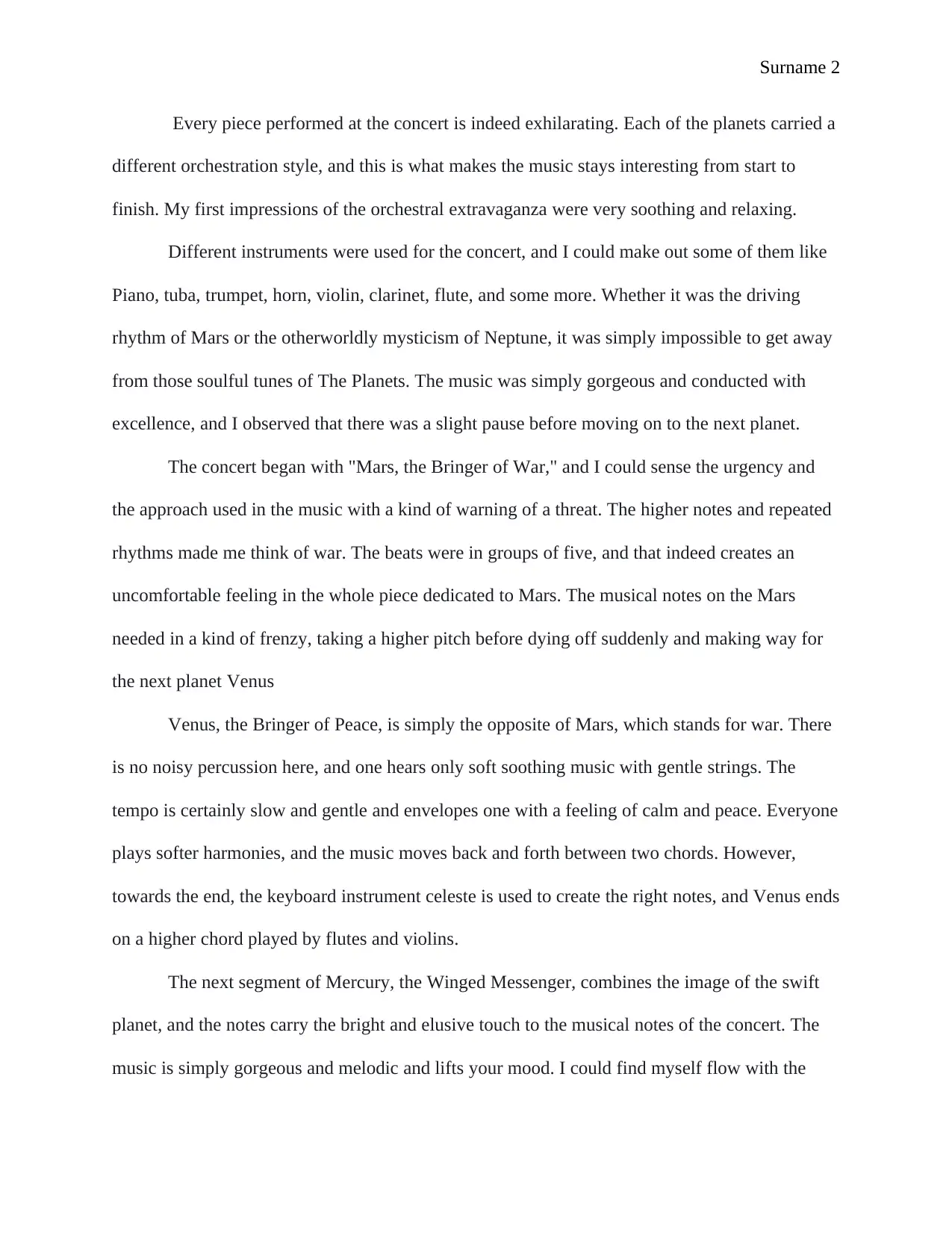
Surname 2
Every piece performed at the concert is indeed exhilarating. Each of the planets carried a
different orchestration style, and this is what makes the music stays interesting from start to
finish. My first impressions of the orchestral extravaganza were very soothing and relaxing.
Different instruments were used for the concert, and I could make out some of them like
Piano, tuba, trumpet, horn, violin, clarinet, flute, and some more. Whether it was the driving
rhythm of Mars or the otherworldly mysticism of Neptune, it was simply impossible to get away
from those soulful tunes of The Planets. The music was simply gorgeous and conducted with
excellence, and I observed that there was a slight pause before moving on to the next planet.
The concert began with "Mars, the Bringer of War," and I could sense the urgency and
the approach used in the music with a kind of warning of a threat. The higher notes and repeated
rhythms made me think of war. The beats were in groups of five, and that indeed creates an
uncomfortable feeling in the whole piece dedicated to Mars. The musical notes on the Mars
needed in a kind of frenzy, taking a higher pitch before dying off suddenly and making way for
the next planet Venus
Venus, the Bringer of Peace, is simply the opposite of Mars, which stands for war. There
is no noisy percussion here, and one hears only soft soothing music with gentle strings. The
tempo is certainly slow and gentle and envelopes one with a feeling of calm and peace. Everyone
plays softer harmonies, and the music moves back and forth between two chords. However,
towards the end, the keyboard instrument celeste is used to create the right notes, and Venus ends
on a higher chord played by flutes and violins.
The next segment of Mercury, the Winged Messenger, combines the image of the swift
planet, and the notes carry the bright and elusive touch to the musical notes of the concert. The
music is simply gorgeous and melodic and lifts your mood. I could find myself flow with the
Every piece performed at the concert is indeed exhilarating. Each of the planets carried a
different orchestration style, and this is what makes the music stays interesting from start to
finish. My first impressions of the orchestral extravaganza were very soothing and relaxing.
Different instruments were used for the concert, and I could make out some of them like
Piano, tuba, trumpet, horn, violin, clarinet, flute, and some more. Whether it was the driving
rhythm of Mars or the otherworldly mysticism of Neptune, it was simply impossible to get away
from those soulful tunes of The Planets. The music was simply gorgeous and conducted with
excellence, and I observed that there was a slight pause before moving on to the next planet.
The concert began with "Mars, the Bringer of War," and I could sense the urgency and
the approach used in the music with a kind of warning of a threat. The higher notes and repeated
rhythms made me think of war. The beats were in groups of five, and that indeed creates an
uncomfortable feeling in the whole piece dedicated to Mars. The musical notes on the Mars
needed in a kind of frenzy, taking a higher pitch before dying off suddenly and making way for
the next planet Venus
Venus, the Bringer of Peace, is simply the opposite of Mars, which stands for war. There
is no noisy percussion here, and one hears only soft soothing music with gentle strings. The
tempo is certainly slow and gentle and envelopes one with a feeling of calm and peace. Everyone
plays softer harmonies, and the music moves back and forth between two chords. However,
towards the end, the keyboard instrument celeste is used to create the right notes, and Venus ends
on a higher chord played by flutes and violins.
The next segment of Mercury, the Winged Messenger, combines the image of the swift
planet, and the notes carry the bright and elusive touch to the musical notes of the concert. The
music is simply gorgeous and melodic and lifts your mood. I could find myself flow with the
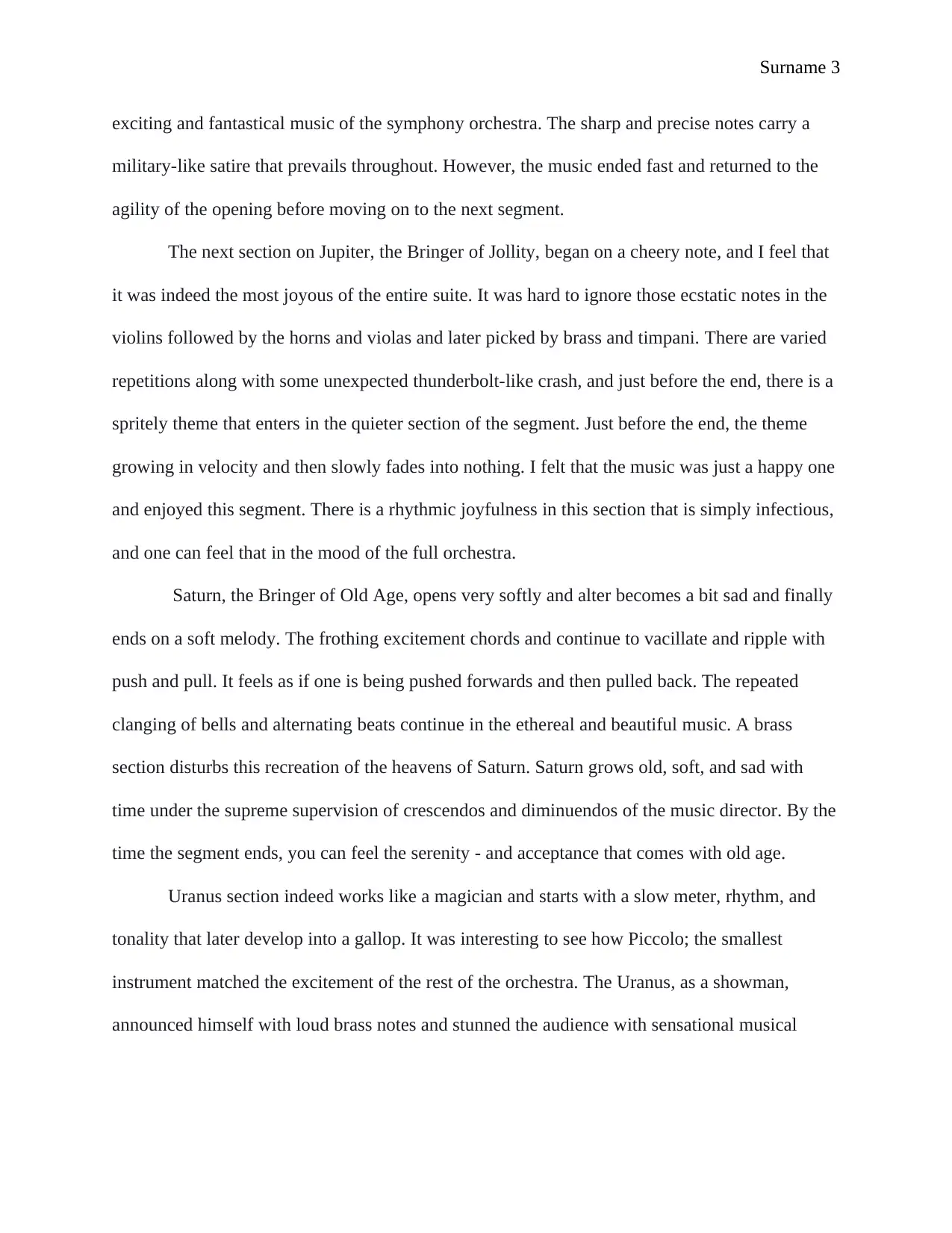
Surname 3
exciting and fantastical music of the symphony orchestra. The sharp and precise notes carry a
military-like satire that prevails throughout. However, the music ended fast and returned to the
agility of the opening before moving on to the next segment.
The next section on Jupiter, the Bringer of Jollity, began on a cheery note, and I feel that
it was indeed the most joyous of the entire suite. It was hard to ignore those ecstatic notes in the
violins followed by the horns and violas and later picked by brass and timpani. There are varied
repetitions along with some unexpected thunderbolt-like crash, and just before the end, there is a
spritely theme that enters in the quieter section of the segment. Just before the end, the theme
growing in velocity and then slowly fades into nothing. I felt that the music was just a happy one
and enjoyed this segment. There is a rhythmic joyfulness in this section that is simply infectious,
and one can feel that in the mood of the full orchestra.
Saturn, the Bringer of Old Age, opens very softly and alter becomes a bit sad and finally
ends on a soft melody. The frothing excitement chords and continue to vacillate and ripple with
push and pull. It feels as if one is being pushed forwards and then pulled back. The repeated
clanging of bells and alternating beats continue in the ethereal and beautiful music. A brass
section disturbs this recreation of the heavens of Saturn. Saturn grows old, soft, and sad with
time under the supreme supervision of crescendos and diminuendos of the music director. By the
time the segment ends, you can feel the serenity - and acceptance that comes with old age.
Uranus section indeed works like a magician and starts with a slow meter, rhythm, and
tonality that later develop into a gallop. It was interesting to see how Piccolo; the smallest
instrument matched the excitement of the rest of the orchestra. The Uranus, as a showman,
announced himself with loud brass notes and stunned the audience with sensational musical
exciting and fantastical music of the symphony orchestra. The sharp and precise notes carry a
military-like satire that prevails throughout. However, the music ended fast and returned to the
agility of the opening before moving on to the next segment.
The next section on Jupiter, the Bringer of Jollity, began on a cheery note, and I feel that
it was indeed the most joyous of the entire suite. It was hard to ignore those ecstatic notes in the
violins followed by the horns and violas and later picked by brass and timpani. There are varied
repetitions along with some unexpected thunderbolt-like crash, and just before the end, there is a
spritely theme that enters in the quieter section of the segment. Just before the end, the theme
growing in velocity and then slowly fades into nothing. I felt that the music was just a happy one
and enjoyed this segment. There is a rhythmic joyfulness in this section that is simply infectious,
and one can feel that in the mood of the full orchestra.
Saturn, the Bringer of Old Age, opens very softly and alter becomes a bit sad and finally
ends on a soft melody. The frothing excitement chords and continue to vacillate and ripple with
push and pull. It feels as if one is being pushed forwards and then pulled back. The repeated
clanging of bells and alternating beats continue in the ethereal and beautiful music. A brass
section disturbs this recreation of the heavens of Saturn. Saturn grows old, soft, and sad with
time under the supreme supervision of crescendos and diminuendos of the music director. By the
time the segment ends, you can feel the serenity - and acceptance that comes with old age.
Uranus section indeed works like a magician and starts with a slow meter, rhythm, and
tonality that later develop into a gallop. It was interesting to see how Piccolo; the smallest
instrument matched the excitement of the rest of the orchestra. The Uranus, as a showman,
announced himself with loud brass notes and stunned the audience with sensational musical
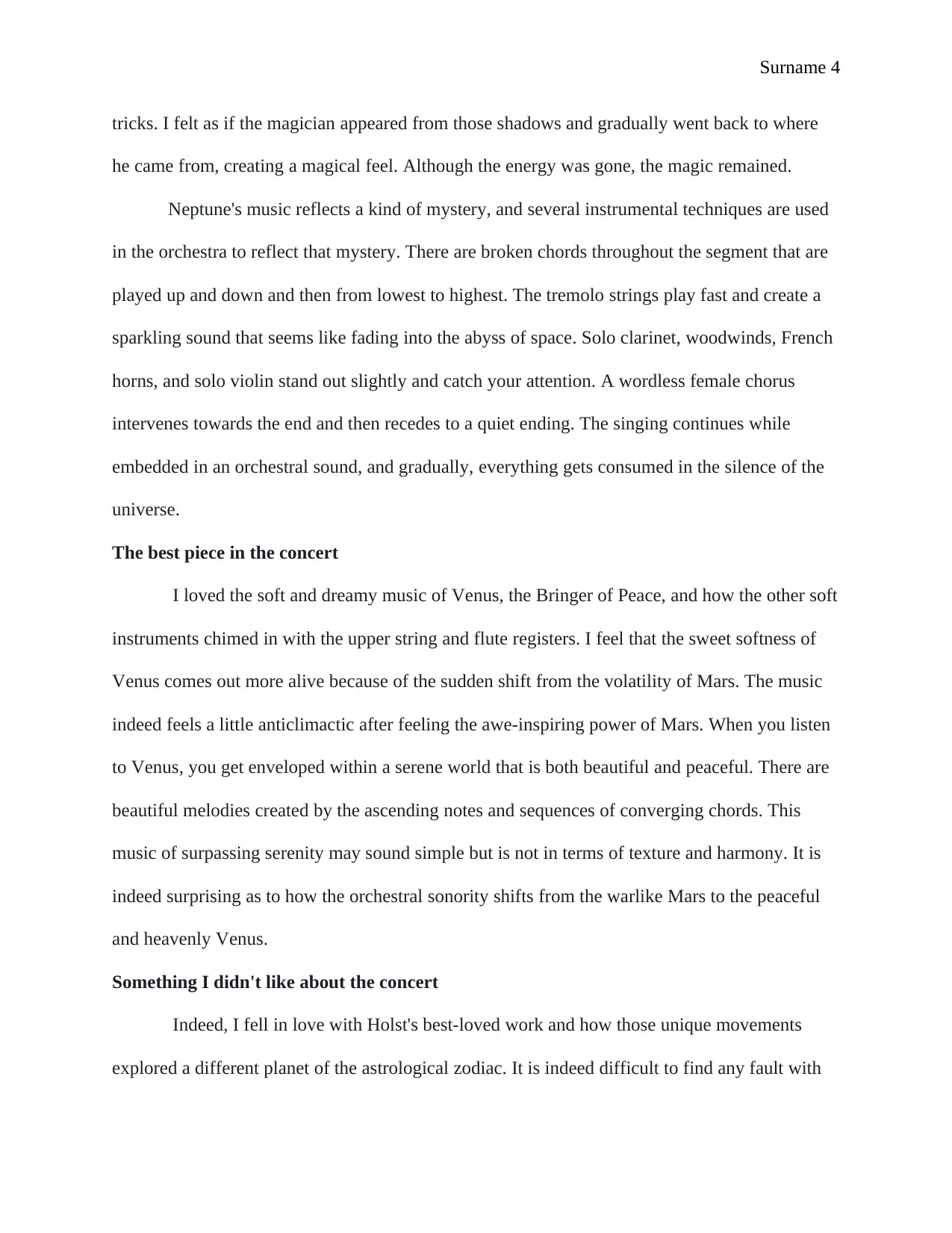
Surname 4
tricks. I felt as if the magician appeared from those shadows and gradually went back to where
he came from, creating a magical feel. Although the energy was gone, the magic remained.
Neptune's music reflects a kind of mystery, and several instrumental techniques are used
in the orchestra to reflect that mystery. There are broken chords throughout the segment that are
played up and down and then from lowest to highest. The tremolo strings play fast and create a
sparkling sound that seems like fading into the abyss of space. Solo clarinet, woodwinds, French
horns, and solo violin stand out slightly and catch your attention. A wordless female chorus
intervenes towards the end and then recedes to a quiet ending. The singing continues while
embedded in an orchestral sound, and gradually, everything gets consumed in the silence of the
universe.
The best piece in the concert
I loved the soft and dreamy music of Venus, the Bringer of Peace, and how the other soft
instruments chimed in with the upper string and flute registers. I feel that the sweet softness of
Venus comes out more alive because of the sudden shift from the volatility of Mars. The music
indeed feels a little anticlimactic after feeling the awe-inspiring power of Mars. When you listen
to Venus, you get enveloped within a serene world that is both beautiful and peaceful. There are
beautiful melodies created by the ascending notes and sequences of converging chords. This
music of surpassing serenity may sound simple but is not in terms of texture and harmony. It is
indeed surprising as to how the orchestral sonority shifts from the warlike Mars to the peaceful
and heavenly Venus.
Something I didn't like about the concert
Indeed, I fell in love with Holst's best-loved work and how those unique movements
explored a different planet of the astrological zodiac. It is indeed difficult to find any fault with
tricks. I felt as if the magician appeared from those shadows and gradually went back to where
he came from, creating a magical feel. Although the energy was gone, the magic remained.
Neptune's music reflects a kind of mystery, and several instrumental techniques are used
in the orchestra to reflect that mystery. There are broken chords throughout the segment that are
played up and down and then from lowest to highest. The tremolo strings play fast and create a
sparkling sound that seems like fading into the abyss of space. Solo clarinet, woodwinds, French
horns, and solo violin stand out slightly and catch your attention. A wordless female chorus
intervenes towards the end and then recedes to a quiet ending. The singing continues while
embedded in an orchestral sound, and gradually, everything gets consumed in the silence of the
universe.
The best piece in the concert
I loved the soft and dreamy music of Venus, the Bringer of Peace, and how the other soft
instruments chimed in with the upper string and flute registers. I feel that the sweet softness of
Venus comes out more alive because of the sudden shift from the volatility of Mars. The music
indeed feels a little anticlimactic after feeling the awe-inspiring power of Mars. When you listen
to Venus, you get enveloped within a serene world that is both beautiful and peaceful. There are
beautiful melodies created by the ascending notes and sequences of converging chords. This
music of surpassing serenity may sound simple but is not in terms of texture and harmony. It is
indeed surprising as to how the orchestral sonority shifts from the warlike Mars to the peaceful
and heavenly Venus.
Something I didn't like about the concert
Indeed, I fell in love with Holst's best-loved work and how those unique movements
explored a different planet of the astrological zodiac. It is indeed difficult to find any fault with
Secure Best Marks with AI Grader
Need help grading? Try our AI Grader for instant feedback on your assignments.
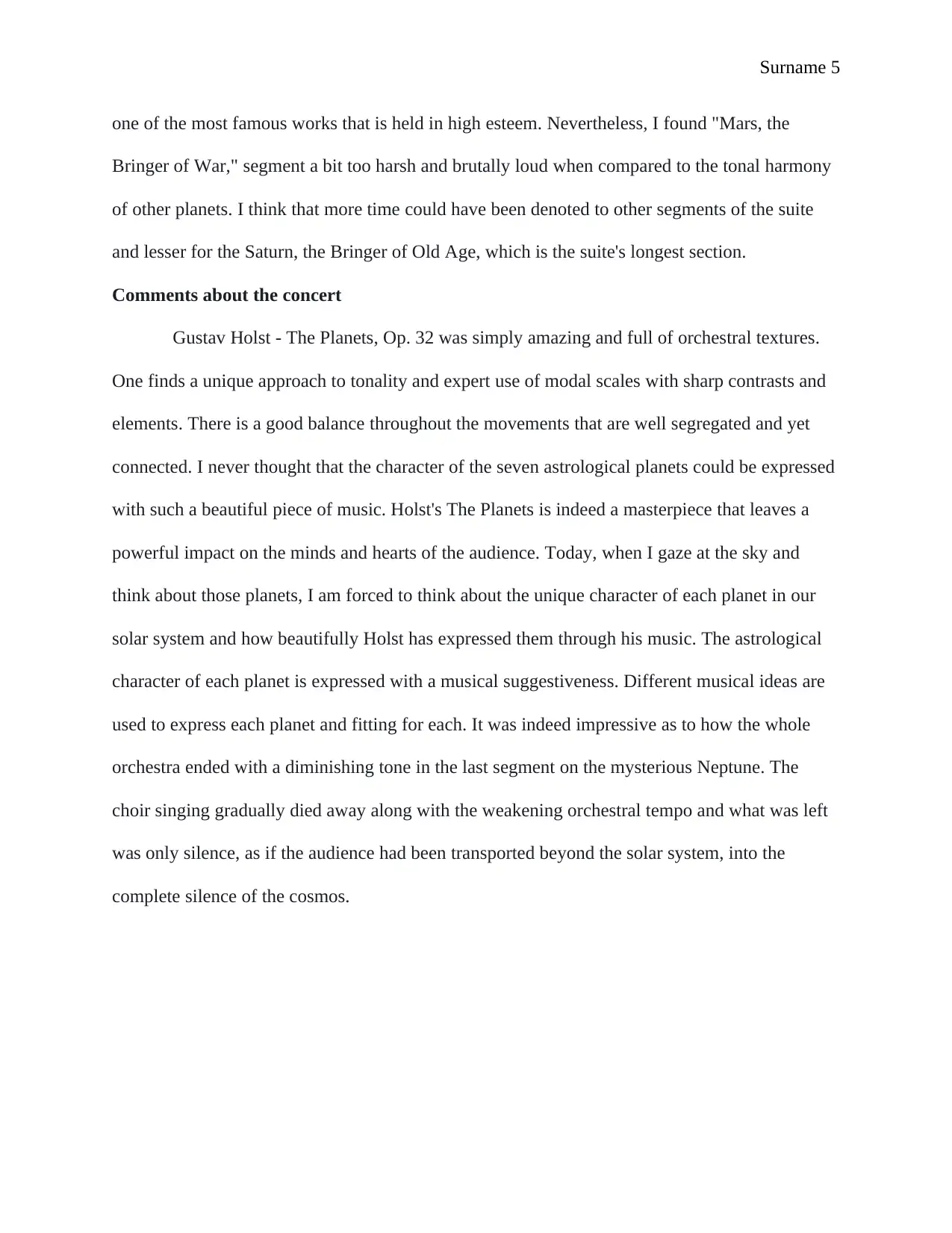
Surname 5
one of the most famous works that is held in high esteem. Nevertheless, I found "Mars, the
Bringer of War," segment a bit too harsh and brutally loud when compared to the tonal harmony
of other planets. I think that more time could have been denoted to other segments of the suite
and lesser for the Saturn, the Bringer of Old Age, which is the suite's longest section.
Comments about the concert
Gustav Holst - The Planets, Op. 32 was simply amazing and full of orchestral textures.
One finds a unique approach to tonality and expert use of modal scales with sharp contrasts and
elements. There is a good balance throughout the movements that are well segregated and yet
connected. I never thought that the character of the seven astrological planets could be expressed
with such a beautiful piece of music. Holst's The Planets is indeed a masterpiece that leaves a
powerful impact on the minds and hearts of the audience. Today, when I gaze at the sky and
think about those planets, I am forced to think about the unique character of each planet in our
solar system and how beautifully Holst has expressed them through his music. The astrological
character of each planet is expressed with a musical suggestiveness. Different musical ideas are
used to express each planet and fitting for each. It was indeed impressive as to how the whole
orchestra ended with a diminishing tone in the last segment on the mysterious Neptune. The
choir singing gradually died away along with the weakening orchestral tempo and what was left
was only silence, as if the audience had been transported beyond the solar system, into the
complete silence of the cosmos.
one of the most famous works that is held in high esteem. Nevertheless, I found "Mars, the
Bringer of War," segment a bit too harsh and brutally loud when compared to the tonal harmony
of other planets. I think that more time could have been denoted to other segments of the suite
and lesser for the Saturn, the Bringer of Old Age, which is the suite's longest section.
Comments about the concert
Gustav Holst - The Planets, Op. 32 was simply amazing and full of orchestral textures.
One finds a unique approach to tonality and expert use of modal scales with sharp contrasts and
elements. There is a good balance throughout the movements that are well segregated and yet
connected. I never thought that the character of the seven astrological planets could be expressed
with such a beautiful piece of music. Holst's The Planets is indeed a masterpiece that leaves a
powerful impact on the minds and hearts of the audience. Today, when I gaze at the sky and
think about those planets, I am forced to think about the unique character of each planet in our
solar system and how beautifully Holst has expressed them through his music. The astrological
character of each planet is expressed with a musical suggestiveness. Different musical ideas are
used to express each planet and fitting for each. It was indeed impressive as to how the whole
orchestra ended with a diminishing tone in the last segment on the mysterious Neptune. The
choir singing gradually died away along with the weakening orchestral tempo and what was left
was only silence, as if the audience had been transported beyond the solar system, into the
complete silence of the cosmos.
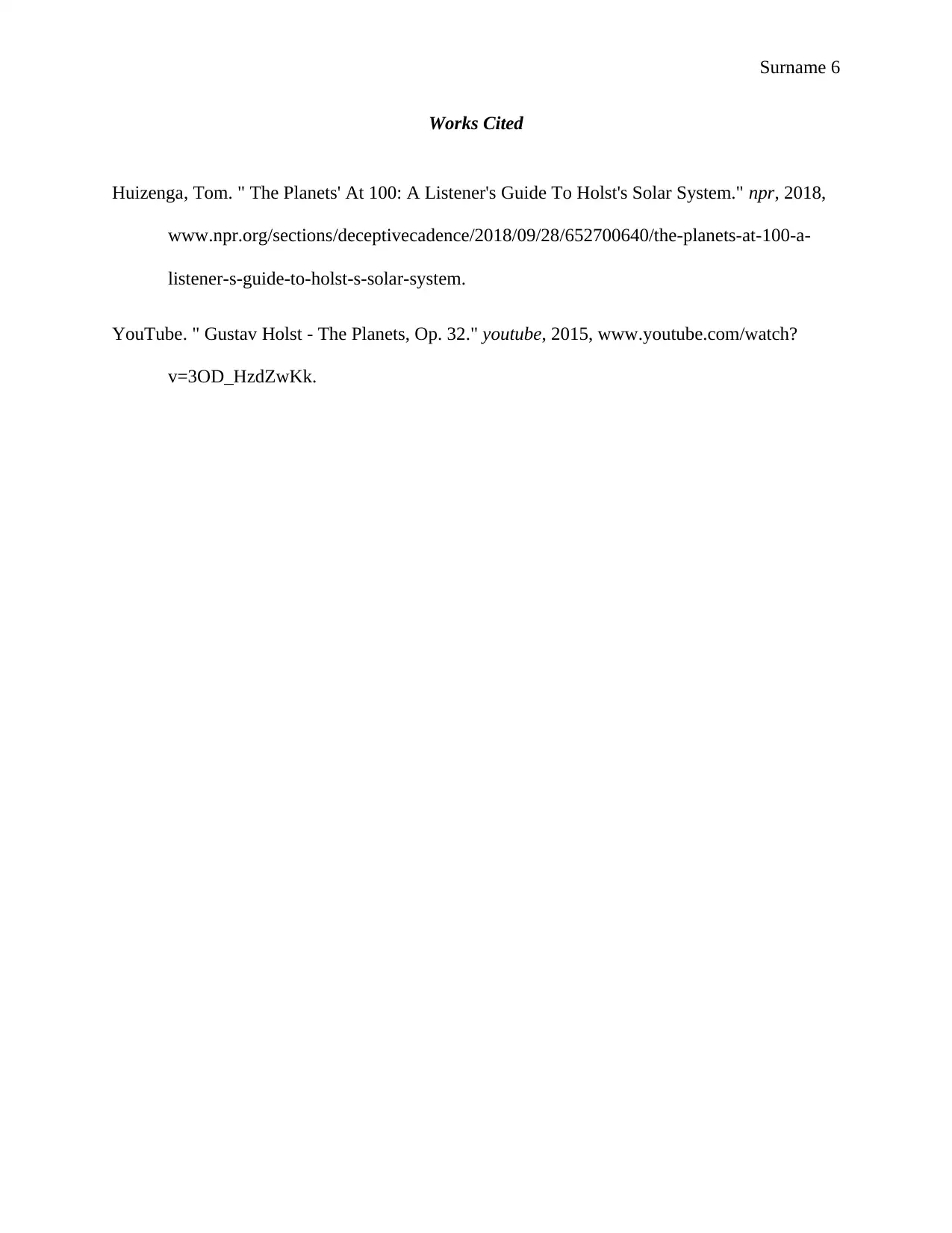
Surname 6
Works Cited
Huizenga, Tom. " The Planets' At 100: A Listener's Guide To Holst's Solar System." npr, 2018,
www.npr.org/sections/deceptivecadence/2018/09/28/652700640/the-planets-at-100-a-
listener-s-guide-to-holst-s-solar-system.
YouTube. " Gustav Holst - The Planets, Op. 32." youtube, 2015, www.youtube.com/watch?
v=3OD_HzdZwKk.
Works Cited
Huizenga, Tom. " The Planets' At 100: A Listener's Guide To Holst's Solar System." npr, 2018,
www.npr.org/sections/deceptivecadence/2018/09/28/652700640/the-planets-at-100-a-
listener-s-guide-to-holst-s-solar-system.
YouTube. " Gustav Holst - The Planets, Op. 32." youtube, 2015, www.youtube.com/watch?
v=3OD_HzdZwKk.
1 out of 6
Your All-in-One AI-Powered Toolkit for Academic Success.
+13062052269
info@desklib.com
Available 24*7 on WhatsApp / Email
![[object Object]](/_next/static/media/star-bottom.7253800d.svg)
Unlock your academic potential
© 2024 | Zucol Services PVT LTD | All rights reserved.